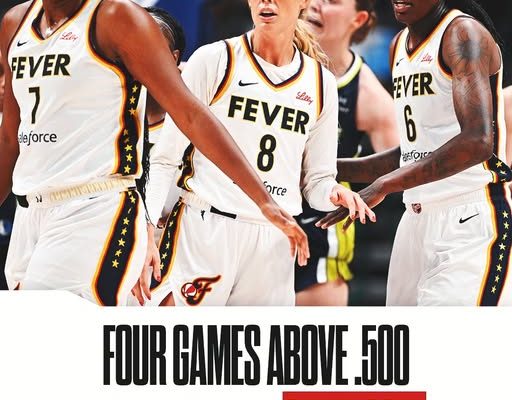The Indiana Fever’s journey back to relevance hasn’t been an easy one. For years, this once-proud franchise—home to legends like Tamika Catchings—has been lost in the shadows of the WNBA’s elite, mired in rebuilds, coaching changes, and a fan base that waited patiently, if sometimes painfully, for signs of a brighter future. But on a humid August evening in Arlington, Texas, the Indiana Fever sent a loud, resounding message to the rest of the league: they are no longer a rebuilding team. They are here. They are dangerous. And, perhaps most symbolically, they are finally four games above .500 for the first time in more than ten years.
The Fever’s hard-fought 84-76 victory over the Dallas Wings at the College Park Center was more than just a win in the standings. It was a statement of purpose. A declaration that the past is behind them, and the future is now. It was also a validation of all the changes that the organization has made—through the draft, through culture, and through the commitment of its rising stars—to return Indiana to the elite company it once enjoyed.
From the opening tip, it was clear that the Fever came to play with urgency and discipline. The Wings, a team struggling to find rhythm amidst injuries and roster inconsistencies, were taken aback by the Fever’s defensive pressure and fluid offensive execution. Indiana’s guards controlled the tempo early, with crisp ball movement and relentless pick-and-roll attacks that put the Wings’ defense on its heels. Kelsey Mitchell, one of the few veterans who has weathered the storm during the franchise’s dark years, played like a woman possessed. Her shot was falling, her confidence was soaring, and her leadership was unmistakable. But what truly made the night special for Indiana wasn’t just Mitchell’s brilliance—it was the collective cohesion that has taken root in the locker room over the past few months.
Aliyah Boston, the franchise cornerstone and former No. 1 overall pick, delivered a performance that blended finesse and physicality. She dominated the paint on both ends, using her superior footwork and basketball IQ to outmaneuver Dallas’s frontcourt. Her presence on the boards and ability to draw double teams opened up the floor for the rest of the team. NaLyssa Smith, another young talent who has blossomed this season, was relentless in attacking the basket, frequently forcing the Wings into foul trouble and converting key free throws. Grace Berger and Lexie Hull contributed timely buckets, and the Fever bench, long a weakness in previous years, held their own in crucial stretches, maintaining energy and momentum when the starters rested.
Perhaps the most striking part of Indiana’s performance was its poise. In seasons past, the Fever were notorious for squandering leads and collapsing under pressure. But on this night, every Dallas run was met with resistance, every momentum shift neutralized by smart decisions and sharp execution. The Fever didn’t just survive—they imposed their will. They dictated terms and demanded respect. This was no longer a team that hoped to win. This was a team that expected to win.
Much of this transformation can be attributed to head coach Christie Sides, who has gradually but undeniably reshaped the team’s identity. Under Sides, the Fever have become defensively sound, opportunistic on the fast break, and more importantly, mentally tough. She has instilled a belief in her players that has translated into consistency, even against higher-seeded opponents. Against Dallas, Sides masterfully adjusted her rotations and defensive matchups, switching to a zone at key moments to disrupt the Wings’ rhythm and force low-percentage shots. Her ability to read the flow of the game and trust her players has helped turn close contests into victories—something the Fever struggled with for years.
But as much as coaching and talent have played a role, this Fever resurgence is also about heart. This is a team that plays for each other. A team that celebrates hustle plays, sacrifices individual stats for team success, and finds strength in its adversity. That chemistry was palpable against the Wings. You could see it in the bench reactions, in the way players picked each other up after missed shots, and in the sheer joy they expressed after sealing the win with a series of defensive stops and clutch free throws. There was a sense of pride that can’t be taught—a belief that the Indiana Fever, long an afterthought in league discussions, are worthy of attention and fear.
This victory also carries historical weight. The last time the Fever were four games over .500 was during the 2012 season, the same year they won their first and only WNBA championship. Since then, the franchise has endured a painful drought, often finishing near the bottom of the standings and missing the postseason. But this win marks a symbolic crossing of the threshold. No longer defined by what they used to be or what they hoped to become, the Fever are now a legitimate playoff threat with the tools and toughness to make noise in the postseason.
In terms of standings, the win keeps Indiana climbing the playoff ladder, and more importantly, solidifies their identity as a team capable of winning tough road games. Winning away from home has historically been one of the biggest hurdles for young teams, but this Fever squad thrives under pressure. With several road games left in the season, including matchups against elite contenders, Indiana’s ability to pull off wins like this bodes well for their postseason aspirations.
The Wings, for their part, looked out of sorts for most of the night. Arike Ogunbowale, the team’s dynamic scoring guard, was held in check for long stretches, thanks to a suffocating Indiana defensive game plan that shadowed her every move. Teaira McCowan had a solid showing inside, but the lack of offensive rhythm and cohesion from Dallas ultimately doomed their efforts. The Wings are clearly missing key pieces and struggling to find balance, but credit should go to the Fever’s execution rather than Dallas’s shortcomings. This was a win earned, not gifted.
What comes next for the Fever is equally exciting. With momentum building and a city re-engaged, the team is entering unfamiliar territory—success. But this new version of the Fever isn’t likely to get comfortable. That much is clear from the way the players talk postgame. They speak of unfinished business, of goals still unmet, of making not just the playoffs, but a deep run once they get there. Veterans like Mitchell and Boston are quick to remind the younger players that this level of focus must be maintained. That one road win doesn’t make a season, but it does mark the beginning of something greater.
Fans, too, are starting to believe again. Social media lit up in the hours following the game, with messages of support, pride, and excitement from across Indiana and the broader women’s basketball community. Season ticket inquiries are up, Fever jerseys are flying off shelves, and local sports radio finally has a new conversation to carry into the fall. For a franchise that had become synonymous with rebuilding, irrelevance, and hardship, this win is more than just a number in the standings—it’s a cultural shift.
There are still challenges ahead, no doubt. The WNBA’s upper echelon remains stacked with powerhouse teams like the New York Liberty, Las Vegas Aces, and Connecticut Sun. But Indiana no longer feels like an easy out or a team that’s just happy to be in the conversation. They’ve found their core, built their chemistry, and cultivated a winning mindset that transcends the box score. They’ve earned the right to believe in more.
Years from now, fans and historians might look back on this night in Dallas as the moment the Fever turned the corner. The night they shed the weight of past failures and stepped boldly into a future of promise and potential. The scoreboard may have read 84-76, but the real number that mattered was four—the games above .500, the years of pain overcome, and the signal that the Indiana Fever are no longer rebuilding.
They’ve arrived.



